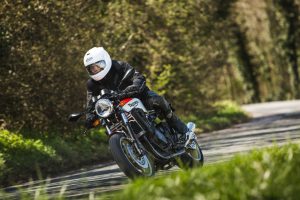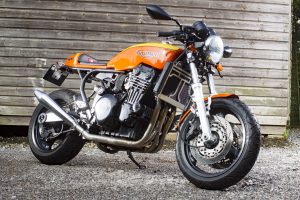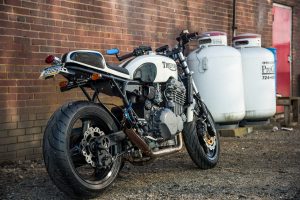Since first spotting the sleek and muscular 1995 Triumph Speed Triple in a local motorcycle dealership, I’ve been a huge fan of the first-generation British triples. They emerged onto the streetbike scene at a time when sportbikes ruled the roads in many places and the early-to-mid 1990s Triumphs were sporty without being garish in their design nor impossibly compromised by tiny rider ergos. Once I convinced the salesman to crank over the water-cooled 12-valve triple, I was smitten: the shop opened officially a few days later and that Speed Triple 900 is still parked in my garage some 44,000 miles later.
Unfortunately, Triumph was just getting a foothold in the American market back then, importing just a few thousand new bikes each year. In time, the Hinckley-made Triumphs proved their reliability and solid roadholding, selling in huge numbers as the lineup evolved and grew. Still, we Americans never developed a reverence for these stout, mile-eating machines like the British did, leaving used prices for the relatively bulky and weighty Sprints, Tridents, Daytonas and Speed Triple 900s (and occasional 1200s) a bit on the low side.
I’m always amazed at how cheaply used 1990s Triumphs can be purchased these days, as they tend to run for decades given proper maintenance and yes, there have been far faster, lighter and more agile Triumphs produced in the decades since, but the early models, in my opinion, were clearly the best of the breed.
Back in the UK where John Bloor’s revised Triumph was born, these machines are downright revered as modern classics. Their used prices are steadily climbing upwards and pristine, low-mileage examples are now the source of heated bidding wars at classic motorcycle auctions.
This si why we weren’t surprised to find the offerings of Cafe Racer kits, an aftermarket parts manufacturer located on England’s Isle of White. The firm was launched about a decade back by Ian Saxcoburg, a former airline engineer who was taken by the smooth power and solid handling of the early Triumph triples. He developed a line of cutting-edge parts kits for the 900cc marvels, comprehensive bolt-on packages that transformed the bikes from staid, sports-tourers into funky, 21st Century cafe racers.
We leapt at the chance to purchase one for a 1995 Trident 900 we’d picked up as a basket case. The CR Kits concept was brilliant in its concept: strip away around 70 pounds of stock bits from the 500-pound bikes, replacing them with specially-made fiberglass bodywork, accessories and a lightweight and very Norton featherbed-inspired rear frame section.
The resultant motorcycle was featured on the cover of Cafe Racer magazine’s 72st issue and it remains one of the most exciting bikes we’ve held onto over the years. The handling is even more precise then ever thanks to the revised chassis while the machine is quicker and easier to maneuver thanks to a loss of some 70 pounds. A rack of flatslide Mikuni carburetors and VooDoo Industries exhausts help makes this Trident a screamer.
A reader recently asked about buying one of the kits for his own 1996 Triumph Sprint, but Cafe Racer Kits no longer sells their parts in the US due to customs issues, the new owner recently told us. It seems the related costs of shipping the extensive parts collections to our country has become prohibitively expensive in recent years, making our modified Trident rarer still. Take a gander at some of the Triumph triples that have been re-born by these remarkable overhauls-in-a-box and we’re sure you’ll agree they managed to improve upon an already formidable breed. Hopefully, we’ll see their likes here again.


